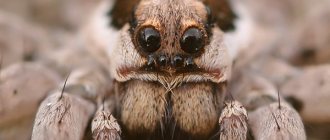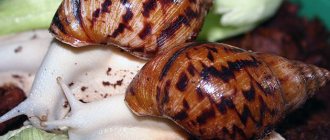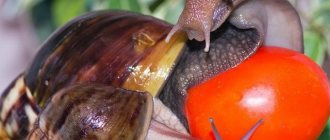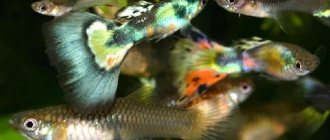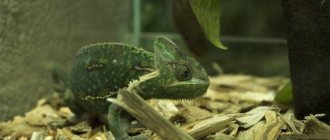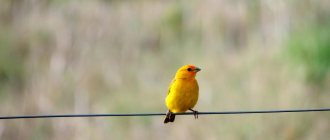What does a tarantula spider look like, its characteristics and structure
The tarantula is an arthropod spider that has an exotic appearance. He has large and fluffy paws and a very bright color; he becomes even more juicy after molting. Their body consists of an abdomen and cephalothorax, united by a bridge, covered with an exoskeleton made of chitin. Such a cover performs a protective function, protecting the tarantula from external damage; in addition, it retains moisture, and this is a very important factor for species that live in arid regions. On the cephalothorax there is a shield - a carapace, on which four pairs of eyes are located.
The abdomen houses the digestive organs and the reproductive system, and at the end of the abdomen there are arachnoid appendages; there can be from two to six pairs of them. The birdcatcher has six pairs of limbs, including four pairs of tarsi, one chelicerae and a pedipalp. They use chelicerae to dig holes, they protect themselves and hunt with them, thanks to them spiders drag caught prey, they also have small glands that contain poison.
With the help of very thin and receptive hairs that are located on their paws, they distinguish different smells and sounds.
size depends on the type of tarantula . Basically it ranges from three to ten centimeters. But you need to add the span of the legs to the size; it can be twenty-eight centimeters. Their weight varies from 65 to 85 grams, but there are individuals whose weight is 150 grams or more, they live in Brazil and Venezuela.
All tarantulas, without exception, are poisonous. But the poison is not fatal for an adult, but for small animals it can be fatal. It is also very dangerous for small children and people who are allergic to spider venom.
Tarantulas do not use venom every time they attack; they can simply bite without using it. When a birdcatcher's bite is poisonous, immediately after the bite a very sharp pain is felt, the temperature rises and convulsions may occur.
On the body of the tarantula there are many hairs that are poisonous; with these hairs the spider protects its nest, weaving it with a web, and in self-defense or in stressful situations it also scratches its abdomen with them.
Characteristic
While spaceships roam the expanses of our vast Universe, scientists on Earth have not yet figured out tarantula spiders. A number of their genera have already been studied, here they are:
- Aviculariinae
- Eumenophorinae
- Harpactirinae
- Ischnocolinae
- Ornithoctoninae
- Phlogius
- Poecilotheriinae
- Selenocosmiinae
- Selenogyrinae
- Stromatopelminae
- Theraphosinae
- Thrigmopoeinae
But don't relax! Within these genera there are up to several dozen species, the listing of which can take quite a lot of time.
There are varieties of tarantula spiders that scientists have not yet thoroughly studied and are still debating where to identify them. In many sources, these insects are grouped under a common “name” - other species of tarantulas. Here they are: Ami Perez-Miles, Brachionopus Pocock, Cardiopelma Vol, Cubanana Ortiz, Kochiana Fukushima, Nagahama & Bertani, Magulla Simon, Proshapalopus Mello-Leita~o.
Within these little-studied species there are subspecies. So, if you dream of having a tarantula spider in your home, which many real and online stores offer to buy today, you will have to work hard to choose from this variety.
It is important to understand that any tarantula spider bite can be poisonous. A photo of his chelicerae indicates that it is also quite painful
The spider's "teeth" can grow up to 2.5 cm in length. However, the venom of tarantulas is not considered fatal, at least so far there have been no recorded cases of human death from a spider bite. People going to the hospital are caused by the body’s reaction to spider venom. You may experience fever, cramps, or severe allergies. In this case, symptomatic remedies will be quite sufficient.
The spider uses venom only to paralyze its victim, but not to poison it. The tarantula kills completely mechanically, striking with sharp chelicerae. However, the reaction to poison in small animals or children can be so strong that without timely “quenching” of the symptoms it can lead to death.
Habitat of tarantula spiders
Tarantulas can be found all over the globe except Antarctica. They live in African countries, in South America, Oceania and Australia and are also found in Europe, but much less frequently than in other countries. Their European ranges are limited to Spain, Portugal and southern Italy.
In the wild , tree spiders live on bushes and trees, and can also live in shelters that are located at ground level and in burrows. In addition, during development, their lifestyle may change: larvae that live in burrows eventually move to the ground. Some of the tarantulas give their preference to tropical and equatorial forests and semi-deserts.
Tarantulas that live in burrows dig them out on their own, after which they strengthen the burrows with arachnids. Tree bird catchers make special tubes from spider webs. Regardless of their mode of existence, all spiders move very little and make some movements only in cases of great need or danger.
Description and lifestyle
This representative of the arachnid class is large in size and is a record holder in its order. In the wild it lives almost everywhere except in very cold climate zones. Lives in burrows, on the ground, in bushes, and in trees. It has about a thousand species in its family, differing in size, speed of growth and movement, body color and temperament.
Appearance of an arthropod
Due to its unusual appearance, the tarantula spider is widely used as an exotic pet . General family parameters:
- The size of the tarantula spider is from 4 to 7 cm with a leg span of 12 to 18 cm. The average weight is from 60 to 100 grams.
- The body color can be monochrome black, dark burgundy, rich yellow, emerald, etc. It has a chitinous shell. After molting, the birdcatcher spider has its brightest color.
- The entire surface of the body and paws are covered with protective hairs, which the animal can weave into its webs. The hairs on the abdomen are poisonous.
- Gifted by nature with six pairs of legs, four of which are the main limbs. The rest are chelicerae and pedipalps.
Hunting method and types of prey
This type of arachnid, despite its harsh name, rarely indulges in meat. The tarantula feeds on lighter and more accessible food, which is easier for its digestive system to cope with. Doesn't weave a web. The hunter hides in ambush, watches and captures the prey, injecting digestive juices into it. It waits until the food is ready to eat and absorbs the life-giving substance.
Most often the diet includes:
- flies, locusts, grasshoppers and other insects;
- small spiders;
- worms;
- baby frogs, small snakes, fish fry;
- chicks, naked mice.
The spider is not afraid of hunger; its female can go without food for months.
But not only arthropod hunters monitor their potential food; bird catchers can also end up on the table of other individuals of their order, scolopendras and other animals.
https://youtube.com/watch?v=UoxeZ1WmHNU
Features of behavior
The temperament of arthropods varies from calm and friendly to extremely aggressive, depending on the species. But they spend most of their lives lazily, not wasting themselves on meaningless body movements. They can sit in ambush for a very long time.
In addition to the vital attack skills, the spider also has defense techniques. It can bite and inject poison, prick with poisonous hairs and even shoot excrement.
Among other relatives of their order, these individuals are very tenacious, although this only applies to females, whose lifespan can reach up to three decades. Males complete their life path after the cessation of molting or within a year after mating.
Depending on the species, tarantula spiders can have either a friendly or aggressive character.
Continuation of the family line
In preparation for his main mission, the male undergoes changes and “man up.” He develops a cymbium - a vessel with seminal fluid. It is attached to the pedipalps. The spider transfers a certain amount of seed to its web. To hold the obstinate darling, tibal hooks grow on the paws. Having met a female, the spider performs a dance in front of her to convince her that he is the one she needs, of the same species. After the “wedding night,” the male tarantula hurries to leave his new wife, otherwise she, if she was hungry, may unceremoniously eat her husband.
To lay eggs, the mother builds a nest from spider webs and fibers from her belly. The number of future children (50-2000 pcs.) is directly dependent on belonging to a particular species. This spider cocoon protects and monitors the temperature. After 20−106 days, the baby nymphs hatch. After two molts, they develop into larvae similar in appearance to their parents. All this time, the youngsters feed on their own resources, that is, the reserves of nutrients in the abdomen, carefully laid down by nature. After several more molts, the larvae become an imago - a full-fledged adult.
It is worth noting that in the life of a spider, molting is a very important process, practically the engine of the animal’s development. With each shedding of its armor, the tarantula grows and progresses, but also ages. You can tell its age by the number of molts.
Tarantula nutrition
Tarantulas wait for their prey somewhere in shelters and do not catch them in spider webs. Contrary to their name, tarantulas do not eat large birds and can constantly feed and digest meat or birds, so they mainly feed on insects :
- small spiders;
- cockroaches;
- small crickets;
- flies;
- locusts;
- mosquitoes.
And an adult tarantula can eat small birds, frogs, various rodents, fish and snakes.
Types of tarantulas
At the moment, the family of these arthropods is divided into thirteen subfamilies, which have many species. Description of some of them:
- Black and white Brazilian tarantula . This tarantula is not very aggressive and has a completely unexpected character. It has a very bright color and grows quickly. Its size is from seven to nine centimeters, and the span of its legs is from eighteen to twenty-three centimeters. These tarantulas live in Brazil, between stones and tree roots. Females can live up to fifteen years. The optimal temperature for it is twenty-seven degrees, humidity - 80%.
- Red-kneeed Mexican birdcatcher or Brachypelma smitha . This species lives in the southern United States and Mexico. These are large spiders: the body is up to 8 centimeters, the leg span is 17 centimeters. They are mostly black or dark brown in color, and there are red spots on the paws; sometimes you can also see a white border. There are many light pink hairs on the body. These spiders have a calm character and are non-aggressive; their venom is of average toxicity. The lifespan of females is 25–30 years, and that of males is 4 years. They feed on various spiders, insects, mice and lizards.
- The tarantula Avicularia purpurea is a South American species of tarantula, most common in Ecuador. Their body length reaches six centimeters, and their leg span is 14 centimeters. They have a purple-blue color and brick hairs on their paws, and the bristles that are located near the mouth are orange-red. They can be found in pastures, in the hollows of various trees and in secluded areas of residential premises. They are very calm, timid and fast, and very easy to care for, which is why many people keep them at home. The temperature for their comfortable living should not exceed 28 degrees and be less than 25. Air humidity - 85%.
- Tarantula Cyclosternum fasciatum - this species is one of the smallest tarantulas, the largest span of its legs is only twelve centimeters. But, despite this, the female’s body size is five centimeters with a paw span of twelve centimeters, and the male grows up to three and a half centimeters, with a paw span of 9.5 centimeters. Their body color is dominated by dark tones and red shades: the cephalothorax can be brown or red, the belly is dark with red stripes, the legs are black, brown or gray. These tarantulas prefer the tropical forests of Guatemala and Costa Rica. If a spider of this species lives at home, it can be aggressive and nervous.
- The pink Chilean tarantula has a very beautiful appearance and is one of the first in terms of sales among arthropod tarantulas. The size reaches sixteen centimeters along with the paw span. The color contains different tones of brown: chestnut, brown and even pink in places. There are many light fibers on the paws and body. They live mainly in the southwestern United States, also capturing the Atakami desert. The suitable temperature for this species is 25 degrees during the day and 18–20 degrees at night. Air humidity should be at least 60%. Females live 15–20 years. They are not aggressive and have a calm nature.
- The Goliath tarantula or Teraphosa Blonda is the largest spider on earth. The body size of the female is 10 centimeters, and the male is 8.5 centimeters. The weight of an adult can reach 170 grams. But, despite their size, goliath tarantulas have a very calm and modest character and they show aggression in very rare cases. They are brown in color, and their paws are decorated with red-brown hairs. These birdcatchers live in the tropical regions of Suriname, northern Brazil, Guyana and Venezuela. It is forbidden to take these birdcatchers outside their habitat, so it is almost impossible to find them in terrariums or at home.
Keeping pink tarantulas in a terrarium
Several individuals of avicularia can live in one terrarium, but provided that they are all approximately the same size, they must also receive plenty of food, otherwise cannibalism is possible. These spiders are more tolerant of their relatives, compared to other tarantulas. They are considered excellent pets because they do not bite.
The entire body of the tarantula is covered with long bright hairs.
Juveniles can be kept in a clear plastic container with holes to allow fresh air to enter. And adult tarantulas need a vertical terrarium. For 10 individuals there should be at least 140 liters of terrarium. Light the terrarium using a red incandescent lamp.
Inside the terrarium with spiders there should be a large number of secluded places, so driftwood, stones are placed, plants with wide leaves are planted, and the like.
To keep pink tarantulas in captivity, good ventilation must be created in the terrarium. They need high humidity - at least 70-90%. To maintain such humidity, it is enough to place a shallow saucer of water in the terrarium; in addition, the substrate is moistened twice a week. It is better not to spray spiders from above.
A spider can bite if it has nowhere to run, but its bite is not dangerous to humans.
For tropical tarantulas, a temperature of 24-29 degrees is suitable; the higher the temperature in the spider’s home, the faster the metabolism occurs in its body, that is, the pet will have to be fed more often. In the evening the temperature drops by about 5 degrees.
5-8 centimeters of humus, peat moss, vermiculite, wood chips, and coconut shavings are poured as a substrate. The substrate is carefully monitored so that it does not rot. For young spiders, a mixture of peat, moss and vermiculite is used as a substrate. Good ventilation is extremely important for young people, as they are most likely to develop fungi and pathogenic bacteria. The substrate is completely changed approximately once every six months.
To keep a tarantula, you should equip a terrarium.
Reproduction of tarantulas
Male tarantula spiders are ready to reproduce much earlier than females. When a male reaches reproductive age, a cymbium appears on his pedipalps, this is a reservoir for seminal fluid, and tibal hooks are formed on his paws, which are needed to hold the female during the mating period. Before mating, the male begins to weave a web, after which he covers it with seminal fluid, and then fills the cymbium with it. When a male and female meet, they perform special actions that confirm that they belong to the same species.
Mating may end in a few seconds, or it may last many hours. With the tibial hooks, which are formed on the front legs, the male holds the female’s chelicerae, and with his pedipalps he introduces his seminal fluid into her body. During mating, the female tarantula spider can eat the male, so after mating the male tries to escape.
After some time, the female begins to build a nest from the web, where she then lays eggs; there can be from 50 to 2 thousand eggs. How many eggs a female will lay depends on her species. Then, from the nest made, the female forms a cocoon, which is round in shape and contains fibers from the spider’s abdomen. The incubation period lasts from 20 to 106 days, during this period the female guards her cocoon and periodically turns it. If the female is hungry, she can easily eat the cocoon with eggs.
After some time, small nymph spiders begin to appear, which at first do not eat anything and live all together.
After the nymph molts twice, it turns into a larva, this larva is similar to a spider, but unlike a spider, it has nutrients in its abdomen. After some time has passed, the larva begins to molt and turns into a tarantula spider.
What not to feed spiders
After the point about what you can give to spiders as food, we naturally suggest you consider the point about what you can’t give to them as food. So, despite the fact that there is an opinion that a spider can be fed with small vertebrates and even birds (they say, the spider is a tarantula, there is no need to think about what it will eat) - it is still not worth feeding them with frogs, mice and birds
. The fact is that, as practice shows, very often after such feeding spiders begin to get sick and then die completely. Indigestion, or some other reason, but we would not recommend taking risks.
Also, you should not feed spiders with domestic cockroaches, much less release them to hunt them. Cockroaches may turn out to be sick, or migrate to you from your neighbors, having already been poisoned, and after such a noble dinner, your spider may stretch out its legs. Oh, you don't want this to happen, do you?
It is also not recommended to give the spider insects that you yourself caught on the street. It is, of course, good that you care so much about your pet that you turned into a breadwinner for him, but, like cockroaches, such insects can be sick or poisoned, and... goodbye spider.
If circumstances so arise that your spider is left without food, and you do not have the opportunity to purchase such food for it at a pet store (weekends, holidays) so that your pet does not go hungry, you can still go “hunting”. True, collect insects as far from the road as possible. After this, inspect them and rinse them with water. If possible, they can be quarantined; if not possible, hope for the best and feed your spider.
As for the ban on feeding frogs and newborn mice, this is still heavy food for your pet and he will eat it for several days, and during this time it will have time to decompose in a warm terrarium and be filled with cadaveric poisons. If you still can’t wait to see how your spider copes with a mouse, make sure that the animal is healthy and its size does not exceed the size of the spider itself. Since in such an unequal fight it is not known who will emerge victorious.
How often should you feed a spider?
The frequency of feeding depends on the age of the spider
Well, we have cleared up such nuances as what can be given as food and what cannot. Now, let's talk about the frequency of feedings. So, for an adult spider, the optimal diet would be the following schedule - 1-2 times a week. If you see that the spider does not finish its meal and does not look hungry, you can reduce the frequency of feeding and try feeding it once a week. In general, you should be guided by your pet’s appetite: if he wants to eat, let him eat; if he doesn’t want to, don’t force him.
By the way, you can determine whether a spider is full by the size of its abdomen; if it has increased 2-3 times than before the start of the meal, it means that it is better to drive the spider away from the food and take away its remains.
Little spiderlings need to be fed more often - they have a growing body, so their portions should be smaller. Well, giving them live “big” game in the form of mice and frogs is strictly prohibited.
When not to feed a spider
Sometimes your spider will benefit from going on a diet. So, for example, it is not recommended to feed him immediately after molting. In order to find out when you can start giving him food, use this simple formula: what kind of molt was it (it’s better to write down such information in a separate notebook so as not to make a mistake) + 3-4 days to it
, so that the spider’s body becomes stronger.
If you offer the spider food for several days in a row, but it stubbornly refuses it, you shouldn’t be too intrusive. Give him the opportunity to fast. Some spiders may not even eat for several months. This is quite normal for them.
And, by the way, remember the golden rule - you must remove any leftover food (living or already dead) from the terrarium
. Get yourself such a useful habit. Then, for example, you will avoid such unpleasant situations as the birth of small cockroaches in your terrarium (if the female cockroach was pregnant) and their forays into your territory through the ventilation holes.
Tarantula molt
Molting plays a big role in the life of a tarantula spider. After the spider sheds its exoskeleton, it grows approximately one and a half times in size and can even change color. Young spiders molt every month, and adult tarantulas molt once a year. When spiders molt, they lie on their backs, and in this long process some limbs may be lost, but they are restored during subsequent molts. How old a spider is can be determined by the number of its molts.
Before molting, spiders may refuse to eat. Another sign of impending molting is a darkening of the spider’s abdomen or entire color.
What to do if a spider bites you
As mentioned earlier, bites from spiders, which are often kept in homes, are not fatal unless you have allergies. Otherwise, anaphylactic shock may occur with the most negative consequences.
A bite is often accompanied by the following symptoms: itching, redness, pain and swelling in the affected area. Occasionally, malaise may occur and body temperature may rise. All symptoms disappear after a few days. The algorithm of actions in case of a bite is as follows:
- If a limb is affected, it must be tied with a bandage or rope above the bite.
- Wash the puncture site with soapy water and treat with an antiseptic.
- Apply an ice compress.
- Drink plenty of water to speed up detoxification.
- If necessary, take an antihistamine.
Tarantula spider at home
These spiders live in many homes, as they are completely unpretentious and can be bred at home. To prevent spiders from eating one by one, they must be kept alone. You should also follow some rules when keeping a tarantula at home:
- Terrarium . If you decide to get a arboreal spider, then a terrarium with a height of at least thirty-five centimeters will suit it; you will need to place something similar on a tree in it, it can be a large snag. A layer of soil or coconut substrate must be poured onto the bottom. For spiders that live in burrows, you need a long terrarium. A coconut substrate, the thickness of which is at least ten centimeters, is placed at the bottom of such a terrarium. If the spider is young, then the bedding needs to be changed after each molt. If a burrow spider lives in a terrarium, then it needs to create something like a burrow. And also housing for the spider must be provided with a ventilated lid.
- The temperature in the terrarium where the tarantula lives should not be less than twenty-five degrees; for this you need to install a thermal mat or an infrared heater. If the temperature changes sharply, the domestic tarantula may not survive.
- Air humidity should be high, since our pets are from the tropics. It must be at least 80%; to achieve this, it is necessary to periodically spray the substrate in the terrarium with warm water. You only need to spray one corner of the spider’s home and only after the substrate has completely dried.
- Feeding of tarantula spiders . Young spiders need to be fed crickets, fruit flies and cockroaches. You can also give bloodworms and mealworms. Adult spiders need to be fed once or twice a week. Marbled cockroaches, crickets, bloodworms and worms are suitable for them and can also be fed to newborn mice. Food should be given half as much as the spider itself.
King of Spiders - Tarantula Spider _Spiders_
Choosing a home
After choosing a spider, you should think about where it will live. For a spider, it doesn’t matter where to live, the main thing is that the conditions there are good. Food containers can serve this purpose - this will be the best home for the spider if it is still small. You need to make holes in the container for ventilation, fill it with soil and that’s it. Convenient, practical, not expensive. However, if you decide to provide the spider with a more beautiful home, then for this purpose you will already need a terrarium. How to choose a terrarium? It all depends on the type of spider: there are terrestrial, burrowing, arboreal and intermediate species. It is worth considering that the type of young and adult spiders may differ. For ground spiders, horizontal or cubic terrariums are suitable. These spiders can be found much more often walking around your home. For burrows, both a horizontal and a cubic terrarium may be suitable, but it is worth considering that a large amount of soil should be poured into it. In addition, burrow spiders really do not like to be in plain sight and come to the surface only at nightfall, while semi-burrowing species can stay near the burrow and hide in case of danger. Woody species require a vertical terrarium. Such spiders will build air tunnels from their webs, sometimes embedding a small amount of soil into them to strengthen their homes. Regarding the size of the terrarium, it should be said that you should not strive to purchase a huge terrarium, since the animal will be constantly under stress, and this will affect its health. The fact is that spiders prefer to be safe in narrow conditions, so if you put a spider in a large space, you risk its health. In the wild, spiders also look for any voids, cracks in trees, or hollows, or even dig holes themselves where they feel safe. You can arrange the terrarium itself by putting in it shelters for the spider, all kinds of driftwood and decorations. Such arrangement is sometimes even necessary, especially for tree species that require a foundation for building a home. However, when installing natural decor, such as live plants, driftwood, or bark, into a terrarium, you need to be careful - organic materials can begin to rot or mold, and pathogenic bacteria can also develop on them. Such materials should be treated thermally, but in no case should insecticides or toxic substances be used, as they can harm the spider.
Terrarium 30*30*30 cm PetPetZone (spider)
